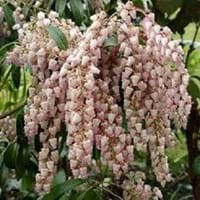Life Span
Perennial
Perennial
Type
Bulb or Corm or Tuber
Broadleaf Evergreen
Origin
South America
Eastern Asia
Types
Pamianthe cardenasii , Pamianthe parviflora , Pamianthe peruviana
Mountain Fire , Variegata , Purity , Red Mill
Habitat
All sorts of environments
Lowland evergreen rainforest, Shaded sites
USDA Hardiness Zone
8-10
5-9
AHS Heat Zone
10-8
Not Available
Habit
Clump-Forming
Upright/Erect
Flower Color
White
White, Red, Light Pink, Hot Pink
Flower Color Modifier
Bicolor
Bicolor
Leaf Color in Spring
Dark Green
Red, Green, Dark Green, Pink, Bronze
Leaf Color in Summer
Light Green
Green, Dark Green
Leaf Color in Fall
Several shades of Green
Green, Dark Green
Leaf Color in Winter
Light Green
Green, Dark Green
Leaf Shape
Strap shaped
Lanceolate to elliptical
Plant Season
Spring, Summer, Fall
Spring, Summer, Fall, Winter
Sunlight
Partial Sun, Partial shade
Full Sun, Partial Sun, Partial shade
Type of Soil
Loam, Sand
Loam
The pH of Soil
Acidic, Neutral, Alkaline
Acidic
Soil Drainage
Average
Well drained
Bloom Time
Spring, Late Spring, Early Summer, Summer, Late Summer
Early Spring, Late Winter
Tolerances
Drought
Deer resistant, Light Frost
Where to Plant?
Ground, Pot
Ground
How to Plant?
Offsets
stem tip cuttings
Plant Maintenance
Medium
Medium
Watering Requirements
Keep the ground moist but not water-logged
Keep the Soil well drained, Requires consistently moist soil
In Summer
Lots of watering
Lots of watering
In Spring
Moderate
Moderate
In Winter
Average Water
Average Water
Soil pH
Acidic, Neutral, Alkaline
Acidic
Soil Type
Loam, Sand
Loam
Soil Drainage Capacity
Average
Well drained
Sun Exposure
Partial Sun, Partial shade
Full Sun, Partial Sun, Partial shade
Pruning
Pinch or prune as they grow to promote branching and bushiness, Remove damaged leaves, Remove dead branches, Remove dead leaves, Requires little pruning
Prune after flowering, Remove damaged leaves, Remove dead branches, Remove dead leaves
Fertilizers
All-Purpose Liquid Fertilizer, High phosphorus
All-Purpose Liquid Fertilizer, fertilize in spring, fertilize in winter
Pests and Diseases
Leaf spot, Mosaic viruses
dieback, Leaf spot, Mites, Soft scales
Plant Tolerance
Drought
Deer resistant, Light Frost
Flower Petal Number
Single
Single
Foliage Texture
Coarse
Medium
Foliage Sheen
Glossy
Glossy
Attracts
Bees, Birds, Bumblebees, Butterflies, Hummingbirds, pollinators
Birds, Butterflies, Hummingbirds, Moths
Allergy
Unknown
Not Available
Aesthetic Uses
Beautification, Bouquets, Ornamental use, Showy Purposes
Beautification, Cottage Garden, Ornamental use, Showy Purposes, Wild gardens
Beauty Benefits
No Beauty Benefits
Not Available
Environmental Uses
Air purification
Air purification
Medicinal Uses
No Medicinal Use
No Medicinal Use
Part of Plant Used
Not Available
Not Applicable
Other Uses
Beneficial species for attracting pollinators, Decoration Purposes
Not Available
Used As Indoor Plant
No
No
Used As Outdoor Plant
Yes
Yes
Garden Design
Bog Garden, Container, Feature Plant, Foundation, Mixed Border, Water Gardens
Feature Plant, Foundation, Hedges, Mixed Border, Screening, Wind Break, Topiary, Bonsai, Espalier
Botanical Name
HYMENOCALLIS longipetala
PIERIS japonica
Common Name
Peruvian Daffodil, Spiderlily
Japanese Andromeda
In Hindi
peruvian daffodil
Japanese pieris
In German
peruvian daffodil
Japanese pieris
In French
peruvian daffodil
Japanese pieris
In Spanish
Pamianthe
Japanese pieris
In Greek
peruvian daffodil
Japanese pieris
In Portuguese
peruvian daffodil
Japanese pieris
In Polish
peruvian daffodil
Japanese pieris
In Latin
peruvian daffodil
Japanese pieris
Phylum
Magnoliophyta
Magnoliophyta
Class
Liliopsida
Magnoliopsida
Order
Asparagales
Ericales
Family
Amaryllidaceae
Ericaceae
Clade
Angiosperms, Monocots
Angiosperms, Asterids, Eudicots
Tribe
Clinantheae
Lyonieae
Subfamily
Amaryllidoideae
Vaccinioideae
Number of Species
Not Available
Not Available
Season and Care of Peruvian Daffodil and Japanese Pieris
Season and care of Peruvian Daffodil and Japanese Pieris is important to know. While considering everything about Peruvian Daffodil and Japanese Pieris Care, growing season is an essential factor. Peruvian Daffodil season is Spring, Summer and Fall and Japanese Pieris season is Spring, Summer and Fall. The type of soil for Peruvian Daffodil is Loam, Sand and for Japanese Pieris is Loam while the PH of soil for Peruvian Daffodil is Acidic, Neutral, Alkaline and for Japanese Pieris is Acidic.
Peruvian Daffodil and Japanese Pieris Physical Information
Peruvian Daffodil and Japanese Pieris physical information is very important for comparison. Peruvian Daffodil height is 61.00 cm and width 61.00 cm whereas Japanese Pieris height is 30.00 cm and width 30.00 cm. The color specification of Peruvian Daffodil and Japanese Pieris are as follows:
Peruvian Daffodil flower color: White
Peruvian Daffodil leaf color: Dark Green
Japanese Pieris flower color: White, Red, Light Pink and Hot Pink
- Japanese Pieris leaf color: Red, Green, Dark Green, Pink and Bronze
Care of Peruvian Daffodil and Japanese Pieris
Care of Peruvian Daffodil and Japanese Pieris include pruning, fertilizers, watering etc. Peruvian Daffodil pruning is done Pinch or prune as they grow to promote branching and bushiness, Remove damaged leaves, Remove dead branches, Remove dead leaves and Requires little pruning and Japanese Pieris pruning is done Prune after flowering, Remove damaged leaves, Remove dead branches and Remove dead leaves. In summer Peruvian Daffodil needs Lots of watering and in winter, it needs Average Water. Whereas, in summer Japanese Pieris needs Lots of watering and in winter, it needs Average Water.





